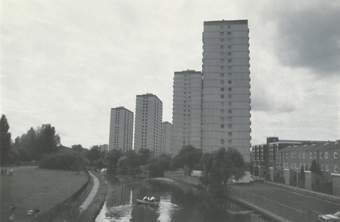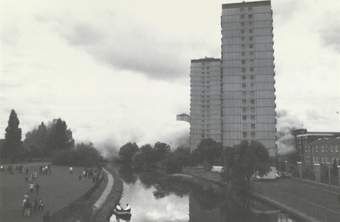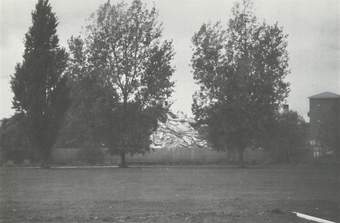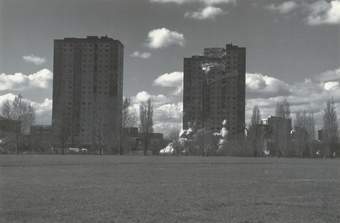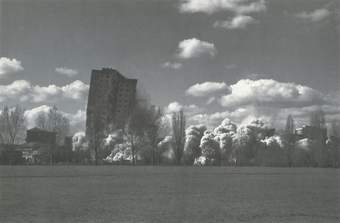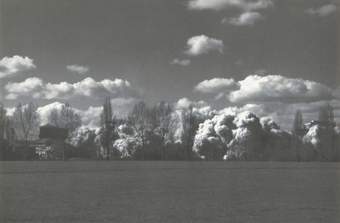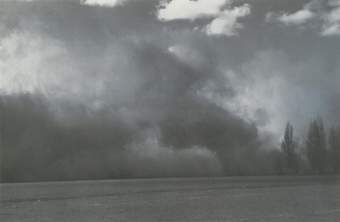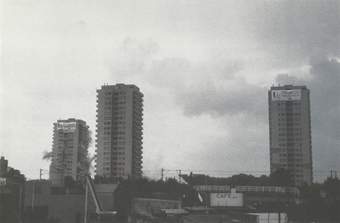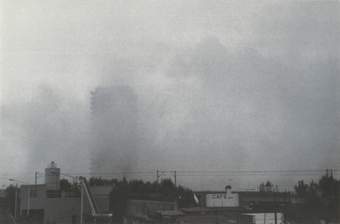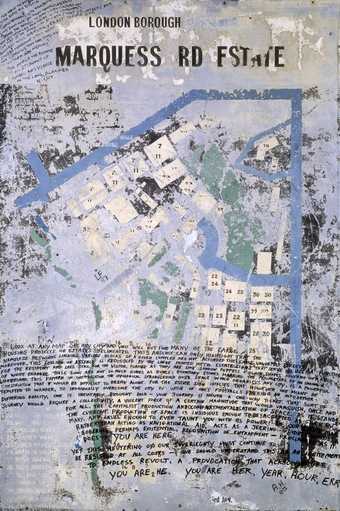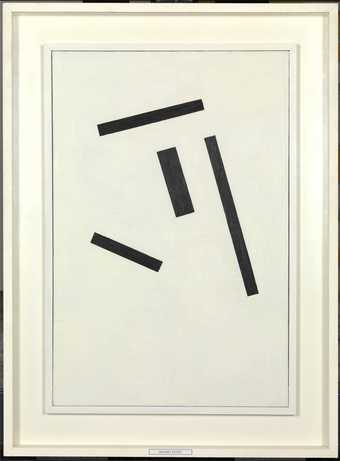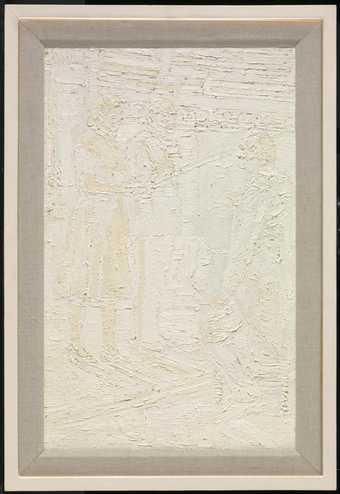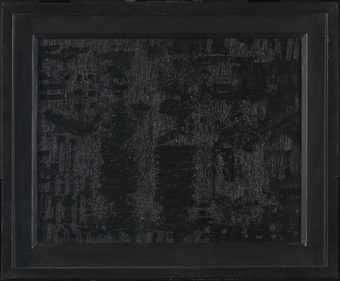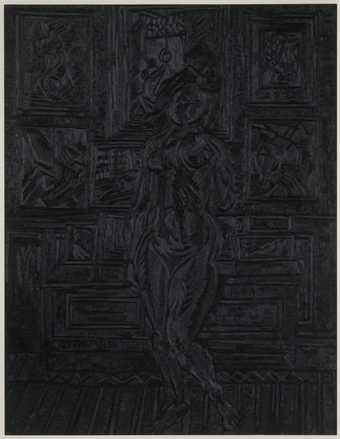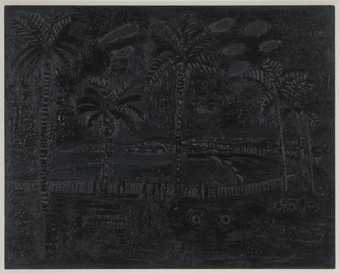
Not on display
- Artist
- Keith Coventry born 1958
- Medium
- Oil paint on canvas, wood and glass
- Dimensions
- Support: 1127 × 821 × 55 mm
- Collection
- Tate
- Acquisition
- Purchased 2006
- Reference
- T12299
Summary
This painting bears a geometric design of bold black graphic blocks descending at an angle from the upper left to lower right corner against a light impasto white ground. Set on a perpendicular grid, the rigid black markings of consistent breadth but irregular length form a flat, variable, abstract pattern. The painting’s simple colouring, form, and ground echo the Russian artist Kazimir Malevich’s suprematist paintings from the early twentieth century; while the rhythmic spatial variation is reminiscent of de Stijl and the Dutch painter Theo von Doesburg’s angular forms that seem to extend endlessly into space.
In fact, Coventry’s painting reflects the arrangement of social housing blocks which make up the East Street Estate in south London, a significant detail which is included on the small nameplate affixed to its wooden frame. Coventry began the ‘Estate Paintings’ in 1991 and has created dozens of different configurations since. Tate’s collection includes two key works from the series: East Street Estate and Heygate Estate 1995 (Tate T12300). For these works the artist reproduces the summary plan depicting the architectural footprint of the buildings on a single council estate at the same scale and in the same colour as represented by the public housing authority on signage near the entrance to each site. The series thus includes diagrammatic variations in dark red (Pelican Estate), brown (Lake View Estate), aubergine (Brockmoor Tower) and yellow (Peckham Park Estate) floating atop white brushwork. Depicted as observed in situ, there is nevertheless a sense of isolation or dislocation to Coventry’s painted colour blocks, which share a relationship only to each other. The standardised forms strangely provide no indication of topography or context beyond the estate’s domain. In this sense both the source itself as much as the painting’s modernist aesthetics are constrained by form and are thoroughly self-referential. But Coventry’s transfer of these simplified structural configurations to the fine art of painting provides a critique of this mode of representation as well as the contemporary sociopolitical conditions, by pointing to the inherent reductionism of an ‘aerial view [which] neatly resolves the complexity of thousands of individual lives into a few cool rectangles’ (Blazwick 1997, p.4).
Coventry’s painting and sculpture from the 1990s use modernist conventions to reflect abstractly on the social realities of urban life – his ‘Estate Paintings’ mark the rupture between the aspirational aesthetic forms of postwar planning and the failure to realise utopia on a social scale. At the same time the series signifies an optimistic, all-encompassing value system; while falling short of grand expectations for a new order, the ‘Estate Paintings’ commemorate a certain moral and political conviction gradually abandoned by the dismantling of the United Kingdom’s welfare state.
The concern for sociopolitical issues particularly situated in the context of south London can further be found both in Queens Road SE15, Planted 1988, Destroyed 1992 1994 (Tate T12298) and Burgess Park SE5, Planted 1983, Destroyed 1988 1994 (Tate T12297), two unique bronze casts of vandalised saplings also in Tate’s collection. This pair of sculptures was first exhibited alongside a number of ‘Estate Paintings’ in Coventry’s 1997 exhibition at The Showroom, London and were included in the display Society Consumed at Tate Britain in 2003, alongside East Street Estate and Heygate Estate.
Further reading
Iwona Blazwick, ‘Vandal’, Keith Coventry, exhibition catalogue, The Showroom, London 1997.
Cheyenne Westphal, Keith Coventry: White Abstracts & Estate Paintings, exhibition catalogue, Galerie Frahm, Copenhagen 1998.
Vanishing Certainties: Keith Coventry: Painting and Sculpture, 1992–2009, exhibition catalogue, Haunch of Venison, London 2009, reproduced p.38.
Kari Rittenbach
February 2012
Does this text contain inaccurate information or language that you feel we should improve or change? We would like to hear from you.
Display caption
At first sight Keith Coventry’s series of Estate Paintings resemble the Suprematist
abstract art
of early twentieth century Russian painters such as Malevich and Rodchenko. Yet these flat geometric patterns are taken directly from standard boards at the entrances to council estates showing the location of each housing block on a simplified plan.
Coventry draws a parallel between the Modernist
drive towards pure form
and the failure of post-war planning to live up to its utopian ambitions. He has painted over a hundred different configurations.
Gallery label, February 2010
Does this text contain inaccurate information or language that you feel we should improve or change? We would like to hear from you.
Explore
- abstraction(8,615)
-
- from recognisable sources(3,634)
-
- man-made(999)
- non-representational(6,161)
-
- geometric(3,072)
- periods and styles(5,198)
-
- modernist(155)
- townscape(3,297)
- formal qualities(12,454)
-
- aerial view(121)
- UK countries and regions(24,355)
-
- England(19,202)
- health and welfare(696)
-
- social housing(20)
- inscriptions(6,664)
-
- map(56)
You might like
-
Inventory Estate Map
1999 -
Keith Coventry Heygate Estate
1995 -
Keith Coventry White Abstract (Investiture of Cecil Beaton)
1995 -
Keith Coventry Black Crack Pipes
1999 -
Keith Coventry Nude in the Studio
2004 -
Keith Coventry Beach at Nice V
2005

